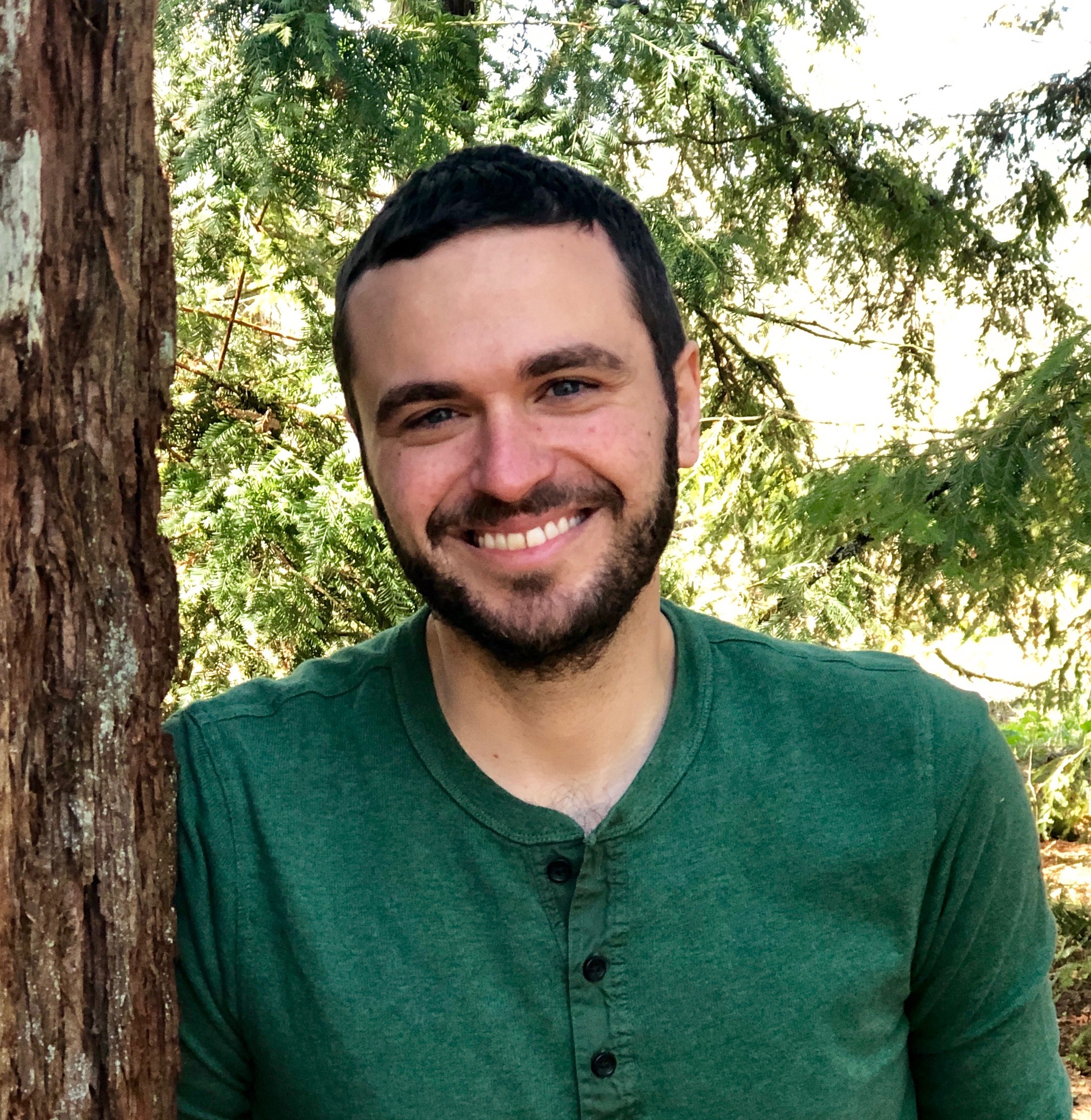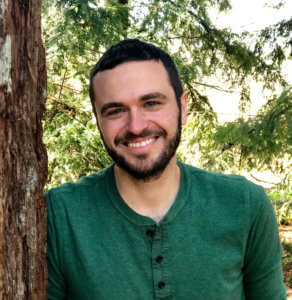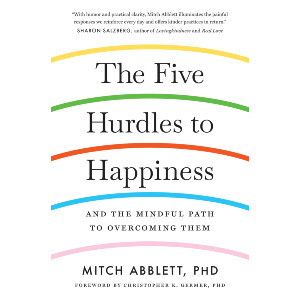

Jonah Paquette
GUIDES

An excerpt from Awestruck
On a beautiful spring day several years ago, I went for a hike in the Muir Woods National Monument, just north of San Francisco. It was a glorious day, with perfect temperatures and sunshine. But despite being in a place some might describe as heaven on earth, my mind just wouldn’t settle down. I can’t recall if it was stress from work, an email I’d neglected to respond to, worries about finances, or something else—I felt my mind bouncing every which way like a pinball, unable to slow down. I had walked about a mile from the trailhead and had taken a small spur trail off to get away from the main foot traffic but was so in my head that I could remember almost nothing about the journey. Frustrated, I sat down on a log. “I’m doing this to relieve stress and be in nature—not get myself all worked up,” I thought to myself. Taking a few deep and slow breaths, I tried to settle my body and mind down.
With no other hikers nearby, I allowed myself the chance to notice the peacefulness of the forest. I closed my eyes and continued to breathe, ten slow and steady breaths. I felt my heart rate begin to slow down, my muscle tension starting to ease ever so slightly. When I opened my eyes, I reflected on what it would be like to see what I was seeing for the first time—to really see it. I began to notice the colors, the hues, and the shapes of the forest around me. I took in the incomparable height of the redwoods, standing hundreds of feet tall, the largest of any living organism on earth. Soon I became struck by the sounds of the forest—the sounds of birds calling, the sounds of leaves rustling, but also the unusual “sound” of silence.
Reaching in front of me, I laid my hands on the trunk of a giant redwood, feelings its texture, and wondered how long it had been there, and how many generations of civilization had come and gone in its lifetime. Standing among these ancient trees, some hundreds of years old and hundreds of feet tall, I felt a profound sense of awe, reverence, and wonder. Lingering a bit longer in the forest, I felt a oneness with the woods, and oneness with other people, and a oneness with the world around me. By encouraging myself to focus, to be exactly where I was—to stop and look and smell and feel and listen—I had managed to calm my restless mind and expand into a feeling of belonging and connection.
In short, I had awakened awe.
Many of us have experienced the therapeutic effects of being in nature. The sights and sounds of a forest, the smell of fresh air, the spray of a waterfall—these experiences give us comfort, beauty, rejuvenation, and a sense of awe. This is not a new idea, of course. Over two thousand years ago, Aristotle remarked that, “In all things of nature there is something of the marvelous.” Since then, countless artists, philosophers, poets, and others have described the power of being in nature. Perhaps the best example of this kinship with nature comes from the naturalist John Muir, who was an instrumental advocate for the preservation of our parks here in the United States. Throughout his life, Muir trekked for thousands of miles across the United States, making his way all the way out to the Sierra Nevada and Yosemite. After feeling awestruck by Yosemite’s beauty, Muir helped push Congress to designate it as a national park, protecting its precious beauty for generations to come.
But despite nature’s impact on our well-being, we are becoming increasingly divorced from our natural world in our daily life. Today, more than half of the world’s population lives in cities, with the number projected to climb to two-thirds by 2050. In America, the average person spends more than 90 percent of their time indoors, disconnected from the natural world. Considering our species has spent roughly 99.9 percent of its existence in a world without permanent structures, let alone skyscrapers, we’ve clearly lost touch with our natural state of being.
This change is unfortunate on many levels, and it has made experiences of awe that much harder to come by.
Indeed, when asked about times in which they last experienced a feeling of awe, roughly three-quarters of people respond with examples of nature.
But while nature may be our primary muse for awe, we’re finding ourselves as a broader culture further and further detached from it. So in the rest of this chapter we’ll explore a number of ways to increase a sense of awe through nature—to intentionally spend more time outdoors both to counter our modern trend of living inside and to connect with and preserve the natural world that sustains life on our planet. Some of the suggestions might be rather easy to pull off, while others might be a bit more challenging and require some more effort. I invite you to approach each practice with an open mind, explore what might excite or inspire you, and use these suggestions as a springboard for cultivating more awe in nature.
Forest Bathing
In the late 1990s in Japan, a practice began to emerge to help remedy the modern dilemma of being disconnected from the natural world. Referred to as shinrin-yoku, it translates as “forest bathing.” Forest bathing is an intentional practice of being in nature and allowing yourself to simply be. The practice doesn’t focus on hiking and doesn’t include actual bathing—instead, it focuses on using your senses, slowing down, and purely being present with nature. Even a relatively short session can do wonders for our well-being and open us up to the potential to experience awe. Over the past two decades, the practice of forest bathing has spread astronomically—perhaps due to an innate sense that we’ve become too cloistered from the natural world. There are now hundreds of professional forest-bathing guides around the world who can help lead people to beautiful places and encourage an immersive, healing experience, as well as forest-bathing books and articles. There’s now significant evidence suggesting that forest bathing can help us in numerous ways, including but not limited to:
- reducing our overall stress
- decreasing stress hormones in our body
- improving our mood
- lowering our blood pressure
- increasing white blood cell activity
- increasing parasympathetic nervous system response
- strengthening our immune system
So, how do we do it? Forest bathing is related to our previous discussions about being mindfully in nature with an intentional focus on sensory immersion and on nature’s potential to heal. Consider the following tips to try forest bathing:
- Begin by finding a quiet, natural place. It can be a forest, but if none are nearby, a park can certainly do the trick.
- Try to leave behind any sources of distraction, including your cell phone or camera.
- Take your time—when you’re starting out, any amount of time will do. But ideally, building up to sessions that last at least thirty minutes is a good goal.
- Pay attention to your senses—your senses are your guide in this experience. Notice the sights that surround you, the sounds, the scents. Observe what it’s like to feel your feet beneath you on the ground, and gently touch something that’s around you. Notice the different colors, textures, lights, and smells. The temperature of the air on your skin. You can even lie down if you’d like, to continue to feel at one with your surroundings.
- Close your eyes and allow yourself to go even deeper into your sensory world. And when you open your eyes once more, notice any details that you may have missed to this point.
- Reflect on the vastness of your environment—how long the trees have been there, how the foliage must have grown over the months and years, the cycles of death and rebirth that happen in the forest, the animals who call this place home, the timelessness of it all.
- Allow a feeling of awe, wonder, and amazement to wash over you. It would have been easy to not truly “see” this place, but with new eyes and an open heart you can allow feelings of awe to take root.
Forest bathing is a simple yet profound practice that can help us reacquaint and immerse ourselves with the natural world. As Philip Barr, an integrative medicine specialist at Duke University, points out, “Forest Bathing could be considered a form of medicine, and the benefits of nature can be accessed so simply.” Indeed, in a world where we’ve become increasingly tied to our electronic devices and rarely interact with nature, forest bathing offers us a simple path to reconnect to these roots and reignite our capacity for awe.
The practice of forest bathing shows how awe can be inspired by the everyday parts of our lives. By turning the unremarkable into something truly special, a casual walk in the woods can be transformed into something far deeper. Indeed, opportunities for awe are all around us—we just need to know where, and how, to look.
The Clouds Above
Looking at the clouds above—truly looking—can be a wondrous experience. There are so many shapes and colors—each cloud is unique and different from the next. It’s no wonder that when children gaze up to the sky, they’ll often “see” various animals, objects, and shapes, and become filled with wonder and amazement. In this regard, we’d be wise to take a page from their book.
For thousands of years and spanning countless cultures, clouds have taken on mythical qualities and have been the source of folklore and legend. The ancient Greeks, for example, believed that the clouds above us were a group of beautiful women (nymphs), who brought water up to the heavens in pitchers. When these pitchers overflowed, the water would cascade down from the sky, nourishing the earth below. The Navajo tribe believed that the clouds in the sky had formed when a great white swan flapped its wings overhead. In Papua New Guinea, people spoke of the legend of Dudugera, the sun, whose heat threatened to scorch the earth below and destroy all life. To stop this, Dudugera’s own mother threw lime in his face, which formed the clouds above us and protected the earth from his intense heat.
Across cultures, clouds have long captured our imagination and offered inspiration. But like with so many parts of our natural world, we’ve lost our connection to this source of wonder. So when you’re next outside, take a moment and look up. Look at the clouds in the sky, immersing yourself in what you see. Notice the colors, the way that the sun’s light passes through them, and observe the various shapes. Remind yourself that right now, in this moment, you’re looking at a cloud unlike any before or since. Fully take in the fact that you’ll never see another cloud quite like this again and allow yourself to rediscover the beauty in the simple act of observing clouds.
Somewhere over the Rainbow
Fun fact: my inspiration for this book came in large part thanks to a rainbow, or rather two rainbows. I was lounging on a beach on the Caribbean island of Saint John late one afternoon, enjoying the powdery soft white sand beneath my feet, and gazing at the impossibly clear blue waters of Maho Bay. Suddenly, without any warning, rain clouds formed overhead, and I was caught in a heavy downpour. I hustled to gather up my belongings and rushed off to my car, soaking wet. After spending a few minutes trying to wait out the rain, it seemed like luck wasn’t on my side and I was about to drive back to the cottage where I was staying. But right at that moment, I looked up and saw the most beautiful double rainbow form over the mountains that served as the backdrop to the beach. The skies suddenly cleared, leaving a jaw-dropping view of the bay with the rainbows behind it. I watched in silence, filled with awe.
When I got back to the cottage that night, I was still on a high of sorts. I became curious about this experience of awe I had just felt—it was a state so familiar to me from many of life’s peak moments. I knew something about the experience of awe, and I wanted to know more. I pulled out my computer and began to look into it further—at excruciatingly slow speed (the internet ran on “island time” too, I suppose). Slowly my excitement built as I learned more about some incredible researchers and their burgeoning insights into the science of awe. I was fascinated and knew in that moment that this was the book I had to write.
The rainbows I saw that day over Maho Bay filled me with wonder, as rainbows have for so many others throughout human history. Across cultures, people have been drawn to rainbows and have been captivated by their beauty. The ancient Greeks believed that rainbows represented Iris, a goddess of the sea and sky and a messenger to the Olympian gods. Other cultures conceived of rainbows as a divine bow of sorts, meant for shooting arrows. And famously, there’s the Irish legend of leprechauns burying their pots of gold at the end of a rainbow.
The science behind rainbows is well understood—they’re formed when light shining through water is bent and reflected, which creates the spectrum of colors we see in them. Remarkably, any time we see a rainbow, we’re the only person in the world seeing it in precisely that form—because it’s all dependent on exactly how light is being reflected back toward us, and each angle of view will subtly change the rainbow’s appearance. But beyond scientific explanation, words often fail when we find ourselves in front of a beautiful and dramatic rainbow. So the next time you happen to see a rainbow, take a moment to linger a bit longer. Think of how many other people might be looking up at that same rainbow but seeing it slightly differently. Reflect on how many people, across so many cultures and centuries, have been mesmerized by rainbows. And take some time to fully absorb the sight of an awe-inspiring rainbow in the sky above.
Share
Related Books







